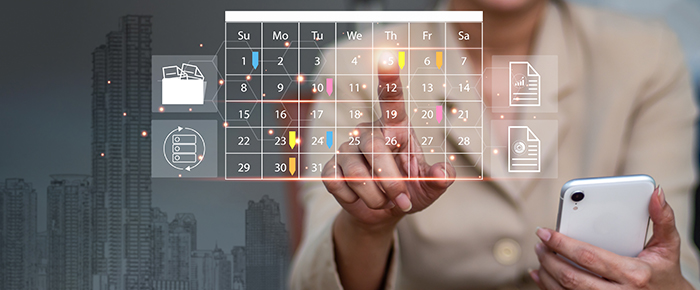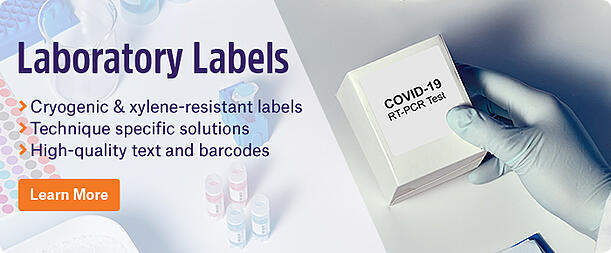
Many labs prioritize sample tracking; after all, most labs focus on generating mass quantities of samples, each of which requires a unique label that often needs to withstand a plethora of conditions. Though lab equipment and tools are never as numerous as experimental samples, efficient tool and equipment tracking requires an appropriate method of identification with the help of specialized labels, barcodes/RFID, and a database to manage them.
Selecting the appropriate label
It goes without saying that all lab equipment should be identified with barcodes (and/or RFID) in combination with human-readable text. However, it’s essential to identify the environmental conditions each piece of equipment will encounter throughout its lifespan. Though most heavy equipment, like mass spectrometers and NMR, might only require general purpose labels, laboratory instruments may be exposed to either relatively high or low temperatures as well as harsh solvents. For instance, machines like sonicators, power supplies, and electrophoresis chambers are frequently used for long periods in cold rooms and may be exposed to any number of solutions containing chemicals such as chloroform, hexane, and glycerol, among others.
Upon purchase, it is recommended to fully assess all possible conditions the instrument may encounter in order to select a label that will ensure the instrument remains well identified for the duration of its lifespan. Because the label will likely need to last many years, perhaps decades, for some machines, lamination may be necessary to prevent fading, regardless of environmental conditions. It is also suggested that these labels are printed using thermal-transfer printers. These printers provide optimal resistance to nearly all stringent lab conditions in addition to abrasion and fading.
Label localization may also play a role in label selection. Figuring out where to best place the label may affect the type of conditions it will encounter (for instance, putting a label on the outside of a freezer vs. inside), and it can also make it easier for those who use the equipment to track and use it. Any label used for identifying instruments should be kept unhidden, with easy access to scan the barcode. If RFID is used to identify the instrument, considerations should be made regarding the surface used for placement, as some surfaces, such as metal, can interfere with the signal. Remember, testing any identification solution with samples from the manufacturer is essential to ensure that it works consistently and accurately in your specific conditions.
Tracking equipment booking, usage, and maintenance
One question that many have is, “Why do I need a barcode on my equipment?” The easy answer is that barcodes allow you to generate a database of all tools and instruments across the entire lab so that personnel can keep track of what is missing. The other reason barcodes (or RFID) are useful on equipment is their ability to allow users to track equipment booking, usage, and maintenance. With a system like FLUICS, which allows you to print custom barcodes that directly link to your LIMS or booking system, you can easily print identifiers that will enable personnel to scan the equipment, giving them instant access to apps such as Clustermarket for tracking equipment usage.
Services like Clustermarket are primarily used for booking equipment; they make it easy for anyone, whether a new graduate student or an established laboratory technician, to access the database easily and quickly book time on the equipment. Systems like Clustermarket have become indispensable additions to academic and industrial labs; with so many potential users for any number of both small and large instruments, any overlap in equipment booking risks wasting entire experiments, increasing costs, and sometimes even squandering irreplaceable samples.
Clustermarket is unique in that it also provides methods to track instrument usage as well as general upkeep and maintenance contracts. Tracking usage is advantageous for a few reasons:
- It helps assess when the machine might require new parts or maintenance (e.g., it can account for the number of hours a microscope halogen bulb was used)
- For large labs or central facilities, it helps keep track of users for billing purposes
- If anything goes wrong with an instrument, it identifies the parties involved so that the problem can be fixed accordingly
Regarding maintenance contracts, having a service that includes a database listing contract type, equipment covered, types of repairs covered, contract length, expiry dates and reminders, and renewal dates can help keep your instruments well-maintained in the long run. Instead of using a paper-based management method, which can lead to contacts being forgotten and risks equipment not being covered (especially problematic if a critical error does occur), the Clustermarket system alerts users when contracts are due for renewal and tracks any issues that may arise. Ultimately, this keeps key personnel on point when a repair is required and mitigates issues where staff want to use a machine but can’t because no one has called to get it fixed.
Identifying all lab instruments and machines is critical for proper management. Using barcode or RFID labels with a booking system can help eliminate costly errors, like workflow bottlenecks. Overall, the benefits of selecting appropriate barcode/RFID labels to track instruments and combining them with equipment booking software include:
- Ensuring all instruments and machines are appropriately identified for the duration of their lifespan
- Tracking equipment location and usage, including billing and repairs
- Managing service contracts, vendors, and equipment in a single, easy-to-access database
LabTAG by GA International is a leading manufacturer of high-performance specialty labels and a supplier of identification solutions used in research and medical labs as well as healthcare institutions.




